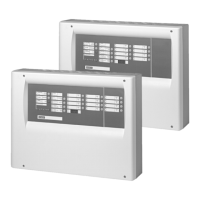System overview
8
Siemens Building Technologies 007995_a_en_--.doc
Fire & Security Products 04.2004
3 System overview
3.1 General
The fire detection system consists of the following modules:
Detectors (detection)
Control unit (evaluation)
Alarm devices (alarming)
1234
8888
Detector zone
Line 1
Remote transmission Fault
Fire control installations
Line 3
Line x
Detector zone
Manual call point zone
Mixed zone
Supply
115/230VAC
Remote transmission Alarm
Line 2
Alarm devices
Detection Evaluation Alarming
Fig. 1 Setup of a fire detection system
Detectors
With detectors, we distinguish between automatic detectors and manual call points.
Automatic detectors monitor a room and automatically trigger alarm in case of fire.
Depending on the type, automatic detectors may react on smoke, flames, or tem-
perature.
Manual call points must always be actuated by a person.
Control unit
All detectors and alarm devices are connected to the fire detection control unit. If a
detector gives alarm, this alarm signal is transmitted to the control unit. The control
unit decides how the alarm shall be processed. This also applies for fault signals.
The processing of alarms and faults differs from one control unit type to the next. It
is e.g. possible to automatically alert the fire brigade, or to activate signal horns.
Alarm devices
Alarm devices only come into operation in case of alarm. In case of alarm, the sig-
nal horns and flash-lights are activated via control lines. In addition, it is possible to
transmit the alarm to an external receiving station (e.g. fire brigade) via a remote
transmission device (RT). In case of fault, it is also possible to inform an external
receiving station.

